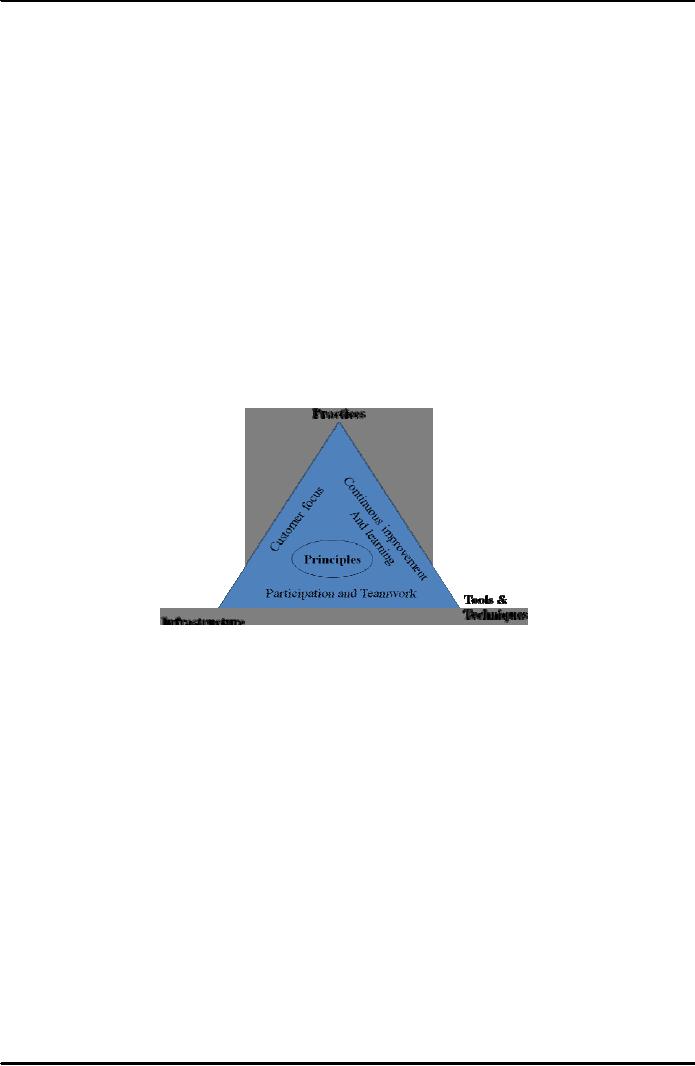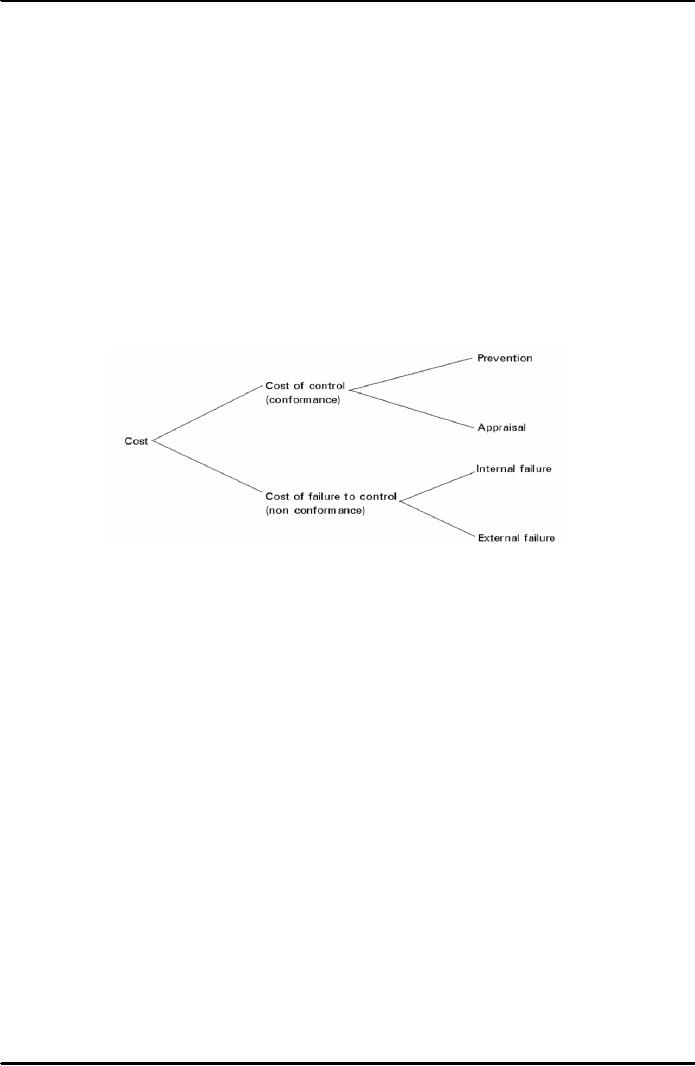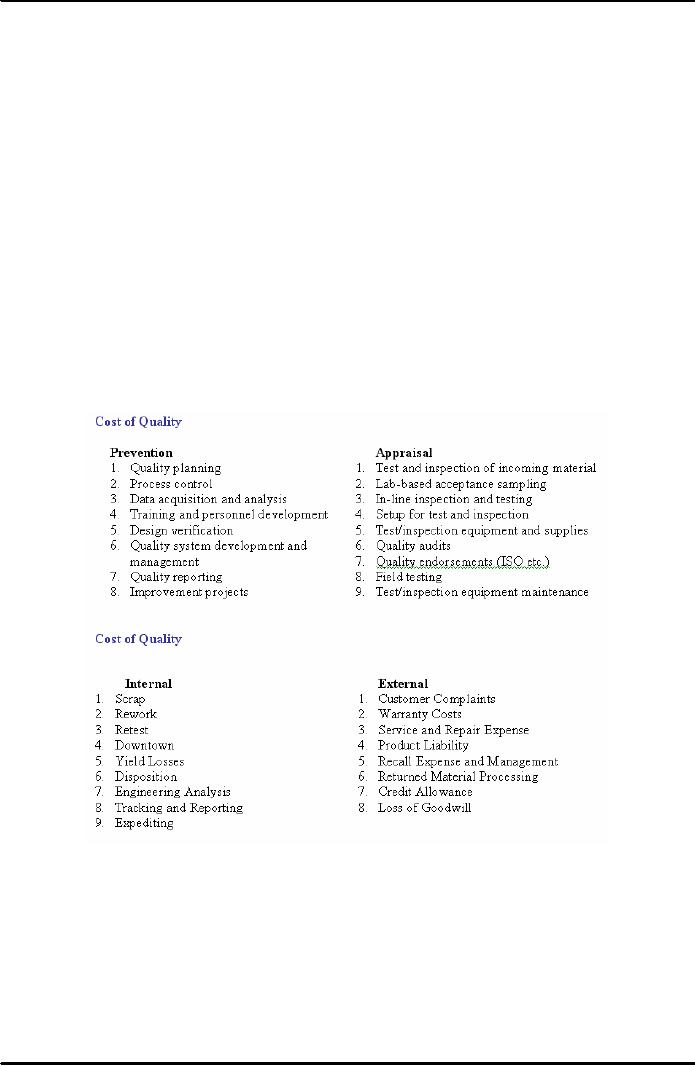 |
PRINCIPLES OF TOTAL QUALITY:EMPOWERMENT, COST OF QUALITY |
| << QUALITY IN PROJECT MANAGEMENT (CONTD.):Total Quality Management |
| CUSTOMER FOCUSED PROJECT MANAGEMENT:Threshold Attributes >> |

Project
Management MGMT627
VU
LESSON
36
PRINCIPLES
OF TOTAL QUALITY
BROAD
CONTENTS
Definitions
of Total Quality
Total
Quality Practices
Principles
of Total Quality
Scope
of Total Quality Management
(TQM)
Empowerment
Cost
of Quality
36.1
DEFINITIONS
OF TOTAL QUALITY:
1.
According to Crosby:
�
Quality
is not only free, it is
profit maker
�
Increase
of 5% -10% in profitability by
concentrating on quality
�
Quality
provides a lot of money for
free
2.
PandG Total Quality Management
(TQM) Definition:
Total
Quality is the unyielding and continually
improving effort by everyone is
an
organization
to understand, meet, and exceed the expectations of
customers.
3.
A V. Feigenbaum:
As
already discussed in lecture
34, A V. Feigenbaum introduced
comprehensive approach
to
quality in 50s by virtue of
which, quality of products
and services were influenced
by the
following
9Ms:
�
Market
�
Money
�
Material
�
Management
�
Machines
�
Men/Women
�
Motivation
�
Mechanizations
�
Modern
Information Methods
�
Mounting
Products Requirements
As
already discussed in the previous
lecture, total quality is a
people-focused management system
that
aims at continual increase in
customer satisfaction at continually
lower real cost. Not
a
separate
area or program.
�
Integral
part of high-level strategy
�
Works
horizontally across functions
and departments
�
Involves
all employees, top to
bottom
�
Extends
backward and forward to include
"supply chain and customer
chain"
36.2
TOTAL
QUALITY PRACTICES:
It
includes the following:
�
Encouraging
openness
262

Project
Management MGMT627
VU
�
Creating
climates of trust and eliminate
fear
�
Listening
and providing feedback
�
Leading
and participating in group
meetings
�
Solving
problems with data
�
Clarifying
goals and resolving conflicts
�
Delegating
and coaching
�
Implementing
change
�
Making
continuous improvement a way of
life
36.3
PRINCIPLES
OF TOTAL QUALITY:
There
are three basic principles of
total quality. These are as
follows:
�
Customer
Focus
�
Participation
and Team work
�
Continuous
improvement (CI) and
learning
36.4
SCOPE
OF TOTAL QUALITY MANAGEMENT:
The
figure 36.1 below depicts the
scope of Total Quality
Management (TQM). It is explained
in
the
ensuing paragraphs.
Figure
36.1: Scope
of Total Quality Management
(TQM)
Infrastructure:
Basic
management system necessary to
function as a high
performing
organization.
Practices:
Activities
that occurs within a management
system to achieve high
performance
objectives.
Tools:
A
wide variety of graphical and
statistical methods to plan
work activities, collect
data
analyze
results, monitor progress, and solve
problems.
36.5
EMPOWERMENT:
Empowerment
means that managers must
relinquish some of power
that they previously
held.
Power
shift creates management
fears that workers will
abuse this privilege.
Employees
have authority and responsibility to make
things happen. No one can be best
at
everything.
But when all of us combine
our talents, we can be best at
virtually anything.
Everyone
in organization is "captain of his
game". He thinks of his work
unit as his "own
business",
and perceives that his "work
unit" is key part of
"corporate enterprise". It
builds
"confidence
in workers" by showing them that company
has confidence in them "to
make
decision"
on their own. Empowerment can be
viewed as vertical teamwork between
managerial
263

Project
Management MGMT627
VU
and
non-managerial personnel. People can be trusted to
make important decisions
about
management
of their work activities.
When people make decisions about
management of their
work,
its result is greater organizational
effectiveness.
As
a whole participation and empowerment
assumes that employees are
willing to improve
their
"daily
work process" and "relationships".
Employee participation is essential
active,
enthusiastic
participation by employees essential to
success of performance improvement
initiative.
Workers
know what goes wrong and
where hurdle in their processes. If
given targets and
support
they are best to develop
creative and effective ideas
for "positive
change".
Problem
for many project based
organization reduction of "bureaucratic
red tape" "that prevents
employees
from seizing the
initiative.
36.5.1
Participative Management:
Participative
organizations are those that
give:
�
Information
�
Knowledge
�
Power
�
Rewards
to all employees so that everyone
can be involved in
organization's
performance
Participative management. It is essential
basis for empowered
workforce.
Put "everybody's intellect" to work
good thinking is not solely
province
of
managers. Different points of
view can help shape
better decision.
Participative
management require that
"responsibility and accountability" takes
to
lowest
possible level empowerment- for three
eyes only creation of
"corporate" spirit of
participation
required that workforce have
information, involvement and
influence.
Participative
management does not imply
abrogation by management of
its
responsibility
it does imply workforce
involvement in decision making
process, but
final
decision on corporate matters remains
responsibility of manager.
When
empowered employees become convinced that
their duty is to their
"process" not
to
their "boss", wonderful
things begin to happen. Teams shoulder
responsibility for
their
"process", and new, more "cooperative
style" of work
evolves.
Empowerment
encourages "innovation" because employees
have authority to "try
out"
new
ideas and make decisions that
result in new ways of doing
things. Access to
information
when employees are given
access to information their
willingness to
cooperation
and to use empowerment is
enhanced.
Due
to this "Accessibility", Teams
"Manage and Control
Opportunity" More
Effectively
Than under old "Hierarchical
Rules and Structure" where access to
info
provided
on A Need to Know
Basis".
264

Project
Management MGMT627
VU
36.5.2
Accountability:
Employees
empowered to make decision, yet
also held accountable for
results.
Accountability
is not to punish person or to
generate immediate, short term
results.
Intent
is to ensure that empowered employees
are:
Giving
their best efforts
a)
Working toward "agreed-upon
goals"
b)
Behaving responsibly toward
each other
36.5.3
Empowerment Some Key
Principles:
�
People
are valuable resource
because they have "knowledge
and ideas".
�
People
want to participate.
�
When
people participate, they
feel empowered; they think
like owners.
�
When
people participate, they
look for ways to improved
opportunities.
�
When
people have importance into
"corporate and department decisions",
better
solutions
are developed.
�
People
should be treated fairly and
with respect.
Organizations
should make long term
commitment for development of
people because
it
makes them valuable to organization.
People can develop knowledge to
make
important
decision about management of
their work
activities.
36.5.4
Six Ways of Empowering Employees
for Quality Improvement in
Projects:
1.
Involve
employees in developing strategies for
continuous improvement.
2.
Provide
employees with skills required
solving problems and making
decisions.
3.
Define
involvement and empowerment based on mission of
organization.
4.
Establish
organizational and individual
goals.
5.
Establish
customer-driven performance measurement at
individual level.
6.
Involve
and empower everyone to focus on continuous
improvement.
Successful
empowerment of employees requires:
�
Employees
should be provided
with:
o
Education
o
Resources
o
Encouragement
�
Policies
and procedures should be examined
for needless
restrictions.
�
Atmosphere
of trust should be fostered rather than
resentment and punishment for
failure.
�
Information
should be shared "freely" rather
than "closely guarded" as "source
of
control
and power".
36.6
COST
OF QUALITY:
To
verify that a product or service
meets the customer's requirements requires the
measurement
of
the cost of quality. For
simplicity's sake, the costs
can be classified as "the
cost of
conformance"
and "the cost of nonconformance."
Conformance costs include items such
as
training,
indoctrination, verification, validation,
testing, maintenance, calibration, and
audits.
Nonconforming
costs include items such as
scrap, rework, warranty repairs,
product recalls, and
complaint
handling.
265

Project
Management MGMT627
VU
Trying
to save a few project
dollars by reducing conformance costs
could prove disastrous.
For
example,
an American company won a contract as a
supplier of Japanese parts.
The initial
contract
called for the delivery of
10,000 parts. During
inspection and testing at the
customer's
(that
is, Japanese) facility, two
rejects were discovered. The Japanese
returned all 10,000
components
to the American supplier stating
that this batch was not
acceptable. In this
example,
the
nonconformance cost could easily be an
order of magnitude greater than the
conformance
cost.
The moral is clear:
Feigenbaum
divided cost of quality into
two categories and four sub
categories:
�
Costs
of Control
o
Prevention
costs
o
Appraisal
costs
�
Costs
of Failure of Control
o
Internal
defect costs
o
External
defect costs
Figure
36.2: Cost
of Quality
�
Prevention
costs are
the up-front costs oriented
toward the satisfaction of
customer's
requirements
with the first and all
succeeding units of product produced
without defects.
Included
in this are typically such
costs as design review, training,
quality planning, surveys
of
vendors, suppliers, and subcontractors, process
studies, and related
preventive activities.
�
Appraisal
costs are
costs associated with
evaluation of product or process to
ascertain how
well
all of the requirements of the customer have
been met. Included in this
are typically
such
costs as inspection of product,
lab test, vendor control,
in-process testing, and
internal
external
design reviews.
�
Internal
failure costs are
those costs associated with
the failure of the processes to
make
products
acceptable to the customer, before
leaving the control of the organization.
Included
in
this area are scrap,
rework, repair, downtime, defect
evaluation, evaluation of scrap,
and
corrective
actions for these internal
failures.
�
External
failure costs are
those costs associated with
the determination by the
customer
that
his requirements have not been
satisfied. Included are
customer returns and allowances,
evaluation
of customer complaints, inspection at
the customer, and customer visits
to
resolve
quality complaints and necessary
corrective action.
Prevention
costs are expected to actually rise as
more time is spent in prevention
activities
throughout
the organization. As processes improve
over the long run, appraisal
costs will go
down
as the need to inspect in quality
decreases. The biggest savings
will come from the
266

Project
Management MGMT627
VU
internal
failure areas of rework,
scrap, reengineering, redo,
etc. The additional time
spent in up-
front
design and development will really
pay off here. And,
finally, the external costs
will also
come
down as processes yield
first-time quality on a regular
basis. The improvements
will
continue
to affect the company on a long-term
basis in both improved
quality and lower
costs.
Also,
as project management begins to mature, there
should be further decreases in the
cost of
both
maintaining quality and
developing products.
Prevention
costs actually decrease
without sacrificing the purpose of
prevention if we can
identify
and eliminate the costs
associated with waste, such
as waste due to:
�
Rejects
of completed work
�
Design
flaws
�
Work
in progress
�
Improperly
instructed manpower
�
Excess
or noncontributing management (who
still charge time to the
project)
�
Improperly
assigned manpower
�
Improper
utilization of facilities
�
Excessive
expenses that do not necessarily
contribute to the project (that is,
unnecessary
meetings,
travel, lodgings, etc.)
Table
36.1: Cost
of Quality
267
Table of Contents:
- INTRODUCTION TO PROJECT MANAGEMENT:Broad Contents, Functions of Management
- CONCEPTS, DEFINITIONS AND NATURE OF PROJECTS:Why Projects are initiated?, Project Participants
- CONCEPTS OF PROJECT MANAGEMENT:THE PROJECT MANAGEMENT SYSTEM, Managerial Skills
- PROJECT MANAGEMENT METHODOLOGIES AND ORGANIZATIONAL STRUCTURES:Systems, Programs, and Projects
- PROJECT LIFE CYCLES:Conceptual Phase, Implementation Phase, Engineering Project
- THE PROJECT MANAGER:Team Building Skills, Conflict Resolution Skills, Organizing
- THE PROJECT MANAGER (CONTD.):Project Champions, Project Authority Breakdown
- PROJECT CONCEPTION AND PROJECT FEASIBILITY:Feasibility Analysis
- PROJECT FEASIBILITY (CONTD.):Scope of Feasibility Analysis, Project Impacts
- PROJECT FEASIBILITY (CONTD.):Operations and Production, Sales and Marketing
- PROJECT SELECTION:Modeling, The Operating Necessity, The Competitive Necessity
- PROJECT SELECTION (CONTD.):Payback Period, Internal Rate of Return (IRR)
- PROJECT PROPOSAL:Preparation for Future Proposal, Proposal Effort
- PROJECT PROPOSAL (CONTD.):Background on the Opportunity, Costs, Resources Required
- PROJECT PLANNING:Planning of Execution, Operations, Installation and Use
- PROJECT PLANNING (CONTD.):Outside Clients, Quality Control Planning
- PROJECT PLANNING (CONTD.):Elements of a Project Plan, Potential Problems
- PROJECT PLANNING (CONTD.):Sorting Out Project, Project Mission, Categories of Planning
- PROJECT PLANNING (CONTD.):Identifying Strategic Project Variables, Competitive Resources
- PROJECT PLANNING (CONTD.):Responsibilities of Key Players, Line manager will define
- PROJECT PLANNING (CONTD.):The Statement of Work (Sow)
- WORK BREAKDOWN STRUCTURE:Characteristics of Work Package
- WORK BREAKDOWN STRUCTURE:Why Do Plans Fail?
- SCHEDULES AND CHARTS:Master Production Scheduling, Program Plan
- TOTAL PROJECT PLANNING:Management Control, Project Fast-Tracking
- PROJECT SCOPE MANAGEMENT:Why is Scope Important?, Scope Management Plan
- PROJECT SCOPE MANAGEMENT:Project Scope Definition, Scope Change Control
- NETWORK SCHEDULING TECHNIQUES:Historical Evolution of Networks, Dummy Activities
- NETWORK SCHEDULING TECHNIQUES:Slack Time Calculation, Network Re-planning
- NETWORK SCHEDULING TECHNIQUES:Total PERT/CPM Planning, PERT/CPM Problem Areas
- PRICING AND ESTIMATION:GLOBAL PRICING STRATEGIES, TYPES OF ESTIMATES
- PRICING AND ESTIMATION (CONTD.):LABOR DISTRIBUTIONS, OVERHEAD RATES
- PRICING AND ESTIMATION (CONTD.):MATERIALS/SUPPORT COSTS, PRICING OUT THE WORK
- QUALITY IN PROJECT MANAGEMENT:Value-Based Perspective, Customer-Driven Quality
- QUALITY IN PROJECT MANAGEMENT (CONTD.):Total Quality Management
- PRINCIPLES OF TOTAL QUALITY:EMPOWERMENT, COST OF QUALITY
- CUSTOMER FOCUSED PROJECT MANAGEMENT:Threshold Attributes
- QUALITY IMPROVEMENT TOOLS:Data Tables, Identify the problem, Random method
- PROJECT EFFECTIVENESS THROUGH ENHANCED PRODUCTIVITY:Messages of Productivity, Productivity Improvement
- COST MANAGEMENT AND CONTROL IN PROJECTS:Project benefits, Understanding Control
- COST MANAGEMENT AND CONTROL IN PROJECTS:Variance, Depreciation
- PROJECT MANAGEMENT THROUGH LEADERSHIP:The Tasks of Leadership, The Job of a Leader
- COMMUNICATION IN THE PROJECT MANAGEMENT:Cost of Correspondence, CHANNEL
- PROJECT RISK MANAGEMENT:Components of Risk, Categories of Risk, Risk Planning
- PROJECT PROCUREMENT, CONTRACT MANAGEMENT, AND ETHICS IN PROJECT MANAGEMENT:Procurement Cycles